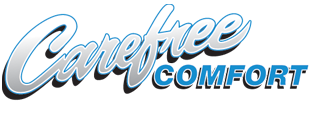Heat Pump 101: How Does This System Cool Your Home?
A heat pump provides one of the most efficient ways to keep your home comfortable with conventional air-forced heating and cooling. It pumps heat between the interior and exterior, which allows it to achieve better energy efficiency in the winter than a furnace that relies on combustion heating to keep you comfortable.
Then, in the summer, a heat pump acts like a high-efficiency air conditioner, cooling your home effectively no matter how hot it gets outside. So just how does this system cool your home? The most common type of heat pump is the air-source variety, so that’s the type we’ll focus on.
How a Heat Pump Cools Your Home
The most basic components of an air-source heat pump are the indoor evaporator coil, the outdoor condensing coil and the compressor that’s part of the outdoor unit. Refrigerant is the key to heat transfer. It begins its journey in the indoor coil, where it arrives in a liquid form. As warm air from your home rushes over the indoor coil, refrigerant inside the coil is heated and turned into a gas. The now cooled air is circulated back into your home.
Next the refrigerant needs to get rid of the heat it has collected. It travels from the indoor to the outdoor coil and passes through a compressor on the way. This constricts the refrigerant, causing it to expel its stored heat to the outside and return to its liquid state. The cycle repeats over and over until the thermostat reads that the desired temperature is reached.
A Look at Heating
In the winter, this process takes place in the opposite direction. Activate the reversing valve and your home is warmed by heat extracted from outdoor air. Air-source heat pumps work best when the temperature is above freezing outside. When conditions get cold, a backup heat source kicks on to make sure you stay comfortable. It can either be an electric resistance heating element (like a toaster) or a gas furnace, as in a dual-fuel system.
Advanced Features
When it comes time to upgrade your heat pump, look for the following features to maximize efficiency:
- Thermostatic expansion valve
- Variable speed blower
- Two-speed compressor
- Improved coil design
- Demand-defrost control
- Grooved copper tubing
To learn more about how heat pumps work, please contact us at Carefree Comfort, Inc. Heating & Air Conditioning in Highland Park today.
Image Provided by Shutterstock.com
You May Also Like

Should I Replace My Carbon Monoxide Monitor in Deerfield, IL?
Winter in Deerfield, IL, brings twinkling lights, cozy fireplaces and the crisp chill that makes your home a sanctuary. But while you’re… Continue Reading Should I Replace My Carbon Monoxide Monitor in Deerfield, IL?…

Fall Maintenance: It’s Time to Check and Clean Your Furnace
Your comfort at home during the fall and winter depends heavily on a reliable heating system. Fall is the perfect season to… Continue Reading Fall Maintenance: It’s Time to Check and Clean Your Furnace…

Should I Replace My Old Furnace Before Heating Season?
The chill of Deerfield’s fall reminds homeowners that heating season is just around the corner. If your furnace has seen better days,… Continue Reading Should I Replace My Old Furnace Before Heating Season?…
